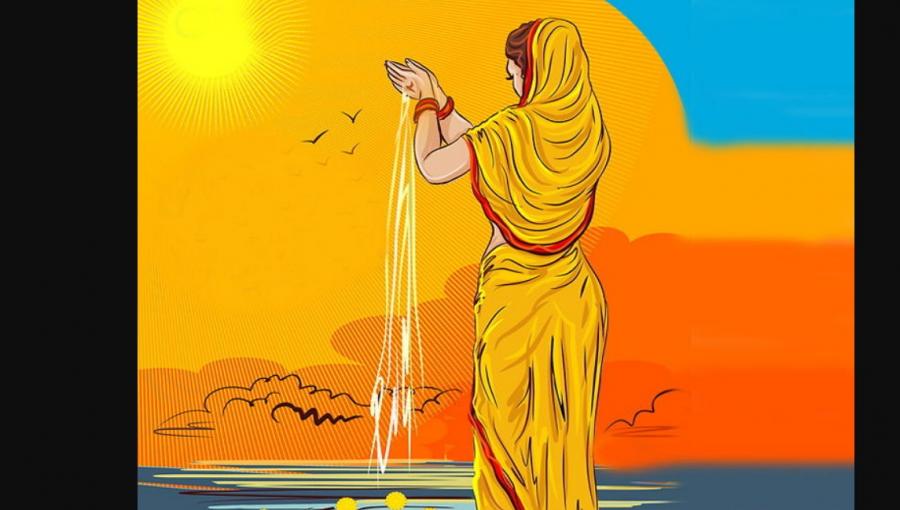‘Chhath Mahaparva' of Bihar: A Historical Retrospect
By :
Notice: Trying to get property 'fName' of non-object in /home/u589520015/domains/observerdawn.com/public_html/module/Application/view/application/index/news.phtml on line 23
Notice: Trying to get property 'lName' of non-object in /home/u589520015/domains/observerdawn.com/public_html/module/Application/view/application/index/news.phtml on line 23

During Vedic period, there lived an ‘asur’ called
'Gayasur' in 'Keekat Pradesh', a vast area spanning most of central India.
Gayasur was an ardent devotee of Lord Vishnu. Gayasur was huge in size. It is
said that when he lay on the ground, his head would fall in northern India and
his legs in the Andhra region. What is important is that his heart
("hriday sthal") would fall in what is today’s Gaya in Bihar.
The
‘devtas’ were very scared of Gayasur as he would trouble them for no reason.
They wanted to get rid of him and so they approached Lord Brahma for relief.
But Lord Brahma told them that He was helpless because Gayasur was among the
greatest devotees of Lord Vishnu and nothing could be done to the supposedly
atrocious asur.
Next,
the ‘devtas’ approached Lord Vishnu, but He was very hesitant to end the life
of His most ardent worshipper. The ‘devtas’ then suggested to Lord Vishnu that
He could at least allow a ‘yagya’ (‘yagna’), invoking His name, to be performed
on Gayasur’s heart, which lay in the Gaya region.
Lord
Vishnu reluctantly agreed to the idea and approached Gayasur, who realised that
the performance of the ‘yagya’ – that too in Lord Vishnu’s name – would lead to
his instant death. But since he was a great devotee of Lord Vishnu, he accepted
the request.
Lord
Vishnu, in turn, gave a blessing to Gayasur so that his name would never be
forgotten in all times to come. Lord Vishnu blessed Gayasur that the place
where a ‘yagya’ was to be performed on his heart – that is, Gaya – would become
the holiest of the holy places of Hindus, who would have to compulsorily
perform “pind daan” of their ancestors in Gaya and Gaya alone. (The practice
continues since then.)
Now,
the ‘devtas’ started searching for priests who had to be great worshippers of
Lord Vishnu and, thus, could perform the ‘yagya’, but none were to be found.
They then approached Narada who told them that such priests could only be
brought in from Shakya Dweepa in the ancient Iran region.
These
priests were great worshippers of Surya (Sun God) and were also known as “Maga
Brahmins” (Reference ‘Vishnu Purana’ 2, 4, 6, 69, 71). In ancient Irna
language, “Maga” means ball of fire or Surya. The Sun God is also considered a
“swaroop” of Lord Vishnu. (The name "Magadh" can also be traced to
"Maga".)
Seven
such Sun-worshipping priests were, therefore, brought in to the Gaya region to
perform the ‘yagya’ on Gayasur’s heart. These priests, whose descendants
survive even today in the Magadh region, were also known as “Shakdeepi
Brahmins” (Reference ‘Mahabharata’, ‘Bheeshma Parva’ 12, 33/ ‘Bhavishya
Purana’, ‘Brahma Parva’ 139, 142).
These
seven Brahmins subsequently settled down in Gaya and its adjoining districts.
Edicts found in 1937-38 AD in Govindpur of Gaya district mention this.
Following
in the footsteps of the “Maga Brahmins”, the people of the region started the
worship of Sun God. Surya is a “Pratyaksh Devta” (visibile deity) and “Surya
Shashthi” (Chhath) has high scientific significance too. In due course, this
came to be known as “Chhath Vrat”.
The
worship was rather simple and could be performed by common people. Although it
required a lot of rigour, it did need any intervention from the Brahmins. With
time, the significance of Sun worship (Chhath Vrat) grew and the festival
became popular. One reason was that performance of Chhath actually proved
beneficial to the worshippers and their families.
The
origin of Chhath Vrat, therefore, has to be traced in the Magadh (Magah) region
from where it spread to other places. The Shakdeepi Brahmins established Sun
Temples at seven places in Magadh, including Deo, Ulaar, Aungari, Gaya and
Pandarak. (Chhath of Deo is considered extremely auspicious.) The Pandas of
Gaya Dham – which is Hindu’s only "Pitri Teerth" – also call
themselves “Agnihotri Brahmins”. Agnihotri is a direct reference to Surya.
During Chhath, “Usha” and “Pratyusha” are also worshipped along with Surya. Usha refers to dawn or the first light of the day. Pratyusha refers to dusk or the last light of the day. Both Usha and Pratyusha -- popularly known as "Chhathi Maiyya" -- are believed to be consorts of Surya. That is why during Chhath, the worshipper offers prayers to the setting as well as the rising Sun. Krishna's son Samb and Raja Priyavrat are also said to have performed Chhath Vrat in the same Magadh region and benefited.
Credits:
1. Priyaranjan Bharti, a senior Patna-based journalist and
also a Shakdeepi Brahmin from the district's Bihta region
2. ‘Glories of Gaya: Glimpses of History and Archaelogy’,
42nd Indian History Congress Souvenir, Magadh University, Bodh Gaya, 28-30
December 1981
3. Upendra Thakur, MA, DPhil, Professor and Head, Department
of Ancient India and Asian Studies, Magadh University, Bodh Gaya
4. Naseem Akhtar, MA, Curator, Gaya Museum, Gaya
5. Naresh Bannerjee, MA, PhD, Department of Economics, Gaya
College, Gaya
6. Ashish Sinha, Journalist, New Delh
7. Capital Khabar, New Delhi
